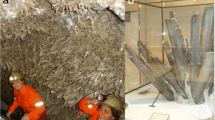Abstract
The mineral inclusions of two orange glass tesserae from paleo-Christian mosaics were investigated in order to derive the melting temperature reached during their production (sourced from Padua and Vicenza, Veneto region, Italy). In particular, clinopyroxene crystals were studied by single-crystal X-ray diffraction and electron microprobe WDS analysis. The crystals show C2/c symmetry, typical of disordered Ca/Na and Mg/Al distributions indicating high-temperature of formation (>700°C). The cation site populations were obtained by combining results from the two experimental techniques enabled us to derive the following stoichiometric formula:
This composition is very close to an ideal diopside (Di, CaMgSi2O6)–aegirine (Ae, NaFe3+Si2O6) solid solution (with composition Di80Ae20). The crystal-structure refinement shows that the Mn, K, Cu, Ti, Zn, Al and Sn “impurities” do not affect the bond lengths and atomic coordinates expected for a pure Di80Ae20. Previous studies report a temperature of formation of about 1250°C, which can be directly applied to the present case, thus inferring the same temperature for the production of the orange glass tesserae.
Similar content being viewed by others
References
I.C. Freestone, in AIHV, Annales du 15 e Congrés, New York–Corning, 2001, press in Nottingham (2003), pp. 111–115
J. Henderson, S.D. McLoughlin, D.S. McPhail, Archaeometry 46, 439–468 (2004)
A. Silvestri, G. Molin, G. Salviulo, Archaeometry 47, 797–816 (2005)
A.J. Shortland, K. Erekim, Archaeometry 48, 581–603 (2006)
M. Lahlil, I. Biron, L. Galoisy, G. Morin, Appl. Phys. A 92, 109–116 (2008)
A. Silvestri, G. Molin, G. Salviulo, R. Schievenin, Archaeometry 48, 415–432 (2006)
Stoe and Cie, Crystal Optimisation for Numerical Absorption Correction (Stoe and Cie GmbH, Darmstadt, 1999)
G.M. Sheldric, SHELX, programs for Crystal Structure Analysis. Gottingen, Germany (1997)
F. Nestola, M. Tribaudino, T.B. Ballaran, C. Liebske, M. Bruno, Am. Mineral. 92, 1492–1501 (2007)
A.J.H. Wilson, International Tables for Crystallography, vol. C, (Kluwer Academic, Dordrecht, 1995)
F. Nestola, M. Longo, C. McCannon, T. Boffa Ballaran, Am. Mineral. 92, 1242–1245 (2007)
I.C. Freestone, in British Museum Occasional Paper 56, Early Vitreous Materials, ed. by M. Bimson M., I.C. Freestone (1987), pp. 173–191
I. Nakai, C. Numako, H. Hosono, K. Yamasaki, J. Am. Ceram. Soc. 82, 689–695 (1999)
M.C. Domeneghetti, M. Zema, V. Tazzoli, Am. Mineral. 90, 1816–1823 (2005)
L. Bindi, O.G. Safonov, V.O. Yapaskurt, L.L. Perchuk, S. Menchetti, Am. Mineral. 88, 464–468 (2003)
L. Bindi, R.T. Downs, G.E. Harlow, O.G. Safonov, Y.A. Litvin, L.L. Perchuk, H. Uchida, S. Menchetti, Am. Mineral. 91, 802–808 (2006)
A.C. McCarthy, R.T. Downs, R.M. Thompson, G.J. Redhammer, Am. Mineral. 93, 1829–1837 (2008)
R.M. Thompson, R.T. Downs, Am. Mineral. 93, 177–186 (2008)
R.D. Shannon, Acta Cryst. A 32, 751–767 (1976)
K. Yagi, Am. Mineral., 976–1000 (1966)
W.D. Carlson, Am. Mineral. 73, 232–241 (1988)
W.D. Carlson, Am. Mineral. 74, 325–332 (1989)
M. Verità, in Il ricettario Darduin, un codice vetrario del seicento trascritto e commentato, ed by R. Barovier Mentasti, M. Verità, A. Tucci (Arsenale Editrice, Venezia, 1986), pp. 25–34,
P.A. Bingham, C.M. Jackson, J. Archaeol, Sci. 35, 302–309 (2008)
Author information
Authors and Affiliations
Corresponding author
Rights and permissions
About this article
Cite this article
Tonietto, S., Nestola, F., Redhammer, G.J. et al. Pyroxene inclusions in paleo-Christian mosaic tesserae: a new tool for constraining the glass manufacturing temperature. Appl. Phys. A 103, 207–212 (2011). https://doi.org/10.1007/s00339-010-5996-2
Received:
Accepted:
Published:
Issue Date:
DOI: https://doi.org/10.1007/s00339-010-5996-2




